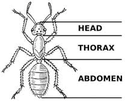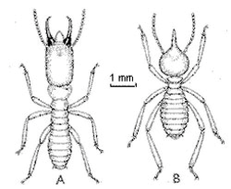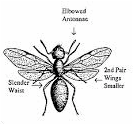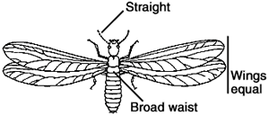What is a termite?
A termite is an order of insects known as Isoptera which means ‘equal winged’. This refers to the winged alate caste that has two sets of wings which are front and rear that are in equal size. The word ‘termite’ is derived from the latin word for woodworm.
Termites are natures recycler/decomposer and contribute by breaking down dead trees and grass into minerals and organic matter. They are also similar to earthworms as subterranean dwellers that tunnel through the top strata and organic material.
This aerates the soil and their excreta provides fertilisers and minerals that enriches the environment and assists with regrowth in areas that might otherwise be barren.
Termite colonies are often used for this purpose when land, which has been used for mining, is being returned back to its original condition.
Termites are an essential part and base element of the food chain with a wide variety of insects and animals, such as lizards, birds, echidnas and ants being dependent on termites as a ready supply of food. They are an extremely nutritious food source that provides sustenance to native wildlife.
Termites are an important and integral function in the inter-relationship between flora and fauna and are an essential and necessary part of the chain of life in nature.
However, termites are best known for the threat that the carry to human shelter. Termites are known for feeding on timber in service within a building, and been known to feed on plasterboard, electrical sheathing, and foraging through concrete within buildings. There are over 2300 species of termites of which about 350 occur in Australia, and of these about 12 damage sound timber.
Ants & Termites – Whats the difference?
It is commonplace for termites to be described as white ants. This is a misnomer as ants and termites are two very separate distinct castes of insects. In fact, termites are more closely related to cockroaches than ants whilst ants belong to an insect order known as hymenoptera that includes bees and wasps.
Ants may also be mistaken for termites as they may occupy similar environments to some termites in decayed wood, however they only excavate decayed tissue & live internally, with no obvious sign of their presence. Australian ants do not attack sound wood, generally do not require treatment & therefore are not timber pests. The differences between ants & termites can be summarised below:
Similarities
- A central colony with several castes
- A social system – survival of the colony is paramount
- Some ant species are found in wood
- Size – many species of ants & termites are similar in size
- Reproductive castes are winged
- Adults of both ants & termites have mandibulate mouthparts
Differences
Ants
Workers
- Elbowed antennae
- Abdominal pedicel present
- Abdomen pointed at end
- Compound eyes present
- Workers are undeveloped female

Termites
Workers
- Antennae like beads
- No abdominal pedicel
- Abdomen blunt at end
- No eyes
- Workers are males & females, sexually undeveloped

Soldiers
- Are workers and have a dual role
Soldiers
- Sexually undeveloped males & females
- Two forms

Reproductives
- Fore & hind wings unequal and strongly veined
- Elbowed antennae
- Distinct abdominal pedicel

Reproductives
- Fore & hind wings equal – veins not obvious
- Antennae like beads
- No abdominal pedicel

Growth
- Has egg, larva, pupa & adult
Growth
- Egg, nymph & adult – no pupal stage
How are termites identified?
Workings
This is extremely difficult to visibly identify as termites are shy creatures, and will die if their body temperature is exposed to significant change. As such they are rarely seen to be found on the surface of materials. If decayed timber stumps or the like are tapped open, workings may also assist in identifying the species of termite. For example, coptotermes acinaciformis workings resemble stacked venetian blinds.
Termite Shelter Tubes
These are earthen tubes, almost always originating from the ground, that are found on walls & foundations. Free-standing ‘stalactite’ tubes are sometimes found transporting termites in a short cut direct from flooring to the ground. Shelter tubes protect termites from most predators & maintain high humidity & darkness during their comings & goings from the main colony area. The tubes are constructed by termites mainly at night when the humidity is usually higher than that during the day, so that soldiers & workers are less likely to desiccate. Shelter tubes enable termites to reach & maintain contact with sources of food that are not accessible to them any other way. Barriers such as metal shields over the foundations may also be crossed by means of these tubes.
Subterranean Tunnels
Subterranean termite species make tunnels through the soil. Timber in, on or above the ground is attacked from these underground tunnels. In the case of the pest species Coptotermes Acinaciformis, the subterranean tunnels, which are mostly in the top 200mm of soil, radiate 50m or more from the nest.
Other subterranean species have similar ranges of activity but those of the more primitive family Termopsidae (Porotermes spp. & Stolotermes spp.) do not have this range. Although the tunnels are used by workers travelling to & from a work source, soldier termites also occur along their length for defence purposes.
Arboreal termites such as Nasutitermes walker build many of their tunnels on the surface of the ground, or within the top centimetre of soil.
Flight holes in trees
Subterranean termites often locate their colonies in trees inside both the trunk & the root crown areas. When the alates are ready to leave the colony at the time of the colonising flight, the workers cut longitudinal slits in the trunk for access. When the flight is completed the workers seal the hole & the tree, in response to the original injury, produces callous tissue which re-covers the hole with natural bark & wood. These raised areas of callous tissue are also known as blowholes and betray the existence of a colony inside a tree. This may be the only external evidence of the colony’s presence.
Flight Tubes
When a colony is about to release alates for the colonising flight from a building workers often build small earthen flight tubes projecting horizontally from infested timber or walls. Where these tubes occur, the colony or nest is usually within a few metres. After the alates have left, the workers seal the tubes.
Earthen Packing
Termites working inside wood may produce large masses of mudlike earthen packing on the outside surface. This type of mudding activity is also found in wall cavities and over foundation walls where they meet the flooring, bearers & joists. Large masses of such mud can serve the purpose of a rehydration area on a long journey from food source to nest.
Excavation of Wood
Termites excavate wood, often leaving only a paint-thin outside layer of wood intact. The type of style of the excavation of the wood differs between species. The pest species Coptotermes Acinaciformis makes narrow flutings inside the wood and Nasutitermes exitiosus hollows out the wood.Mastotermes Darwiniensis makes large galleries running longitudinally with the grain of the wood, but not necessarily leaving the harder growth rings.Schedorhinotermes intermedius particularly excavates the wood around the nails in the flooring.
Termite Noises
The giant termite, Mastotermes Darwiniensis, can be heard feeding on timber, and other species of termites also can be detected with sound amplifying apparatus. In houses & buildings infested with termites, particularly Coptotermes Acinaciformis, an audible tapping sound may sometimes be heard in response to tapping or bumping by an inspector. This appears to be cause by the soldiers tapping their heads & mandibles on the wood, probably as a warning signal to others in their colony that there is some form of danger. This signal is taken up by others along the infested woodwork. Stethoscopes & other sound amplification devices are inspection aids.
Motion detectors
There are devices which by sonar & microwave technology can provide a screen reading that alerts an inspector to the presence of termites in motion behind walls & other surfaces.
Moisture
Large mud-packed areas inside wall cavities may be detected using a moisture meter during an inspection.
Heat
Thermal imaging cameras can detect the slightly warmer temperature of termite activity as a variation on wall surfaces. If the ambient temperature inside the room is warmer than the heat level being radiated out from any mud pack within a wall, or if an air-conditioner has been operating, the surface temperature variation may not exist. Timing the inspection for cooler times of the day gives best results.
Odour
Some species of termites have an odour associated with their presence, which, although generally indistinct, may be detected by humans with a keen sense of smell & dogs trained for this purpose. Nasutitermes exitiosus nests, when opened, have a distinct & characteristic odour. It is thought to be associated with a repellent exudate from the fontanelle at the tip of the nasus.
Presence of alates
When a colonising flight occurs in a building, many of the alates are caught in spider webs in roof voids & in subfloor areas. If dead alates or just their equal sized wings are found in large numbers, the origin should be investigated. Where they are numerous, the flight has probably occurred from nearby and the colony is often very close.
Soldiers & workers appearing singly
Soldiers, and sometimes workers, may enter air conditioning ducts during the night when the systems are turned off. When the air-conditioning is restarted the live termites are blown into living areas. This has occasionally been noted in large office buildings where colonies may have commenced without ground contact, using moisture from air conditioning cooling towers or faulty drainage.
Tree Nests
Arboreal nests are very visible, even in the early development stages. They are often quite dark in colour & seldom the light brown of cankerous growths on the boles of some eucalypts.
Some species of termites often make their nests in the hollow centre of tree trunks or in the root crown area. Evidence of their presence may be exposed workings where a branch has broken off, or the presence of small areas of callous tissue on the trunk of a tree, and may betray the existence of a nest in the tree.
Coptotermes frenchi, Schedorhinotermes intermedius and sometimes Coptotermes acinaciformis build nests in the area of subsidence immediately under the root crown. A metal rod may be used to probe the soil between the roots. As the rod is pushed down towards the centre of the tree, there will be a sudden lessening of resistance if it enters softer nest material. If left in place for a few minutes, it is usually warmer than the outside temperature when withdrawn.
Nests in tree trunks of trees are more difficult to locate, and often it is necessary to drill into the trunk to locate the hollow centre.
Collapsed Timber
So well concealed are termite workings that often the first indication of an infestation is the sagging of structural bearers and joists in floor or roofing timbers, or the accidental discovery of hollowed-out skirting boards or window sills or door hinge screws that release from decreased timber support strength.
Neighbour Experience
When termite activity is found in a building & the source cannot be located, the immediate neighbours may often be able to give information on any history of termites in the area. This may lead to nests being located.
Inspection Aids
All inspection equipment can improve the likelihood of detecting termites; however, the training provided by manufacturers on the strengths & limitations of each type of device should be well understood by technicians. Building owners & prospective owners make significant monetary decisions based on the reports of professional inspectors. Diligence, care and thoughtful consideration of all the above indicators of activity and/or damage cannot be overemphasised.
What to do if you find termites?
An inspector must be contacted upon finding termites, and no action should be taken upon your findings. If the termites are sprayed with household sprays, or if mud tubes are broken, termites may decide to retreat back to the nest. Termite nests are notoriously hard to locate and any tampering may make it hard to locate the termites again. The termites may then relocate and forage in a different direction, eventually causing further damage to your home.
The non-pest species
Of the few hundred Australian termite species, most only attack grass, compost & decaying timber in fences & on the ground & rarely attack timber on & in houses. It is therefore important that costly treatments should not be initiated before the termite species is known.
